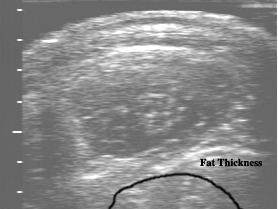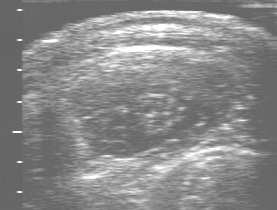
You've reached the Virginia Cooperative Extension Newsletter Archive. These files cover more than ten years of newsletters posted on our old website (through April/May 2009), and are provided for historical purposes only. As such, they may contain out-of-date references and broken links.
To see our latest newsletters and current information, visit our website at http://www.ext.vt.edu/news/.
Newsletter Archive index: http://sites.ext.vt.edu/newsletter-archive/

Understanding Sheep Ultrasound Measurements for Carcass Traits
Livestock Update, August 2001
Scott P. Greiner, Extension Animal Scientist, Sheep, VA Tech
The use of real-time ultrasound technology allows for the objective estimation of carcass traits in live animals. Ultrasound technology is used extensively in beef cattle and swine, and has been an important tool for the genetic improvement of carcass merit in these species. Although ultrasound has been used on a limited basis in sheep, it does offer the same opportunity to quantify conformation in an objective manner. Carcass traits should be considered along with other traits of economic importance (reproduction, growth, maternal ability) when selection decisions are made by flock owners. Since carcass traits are highly heritable, a significant portion of the differences measured in rams or ewes for these traits should be passed on to their progeny and directional change for these traits can be accomplished in a relatively short time.


Fat thickness:
External fat thickness (back fat) is quantified at the 12-13th rib and measured directly over the ribeye muscle. Fat thickness is the most important measurement affecting carcass cutability, and has an inverse relationship with the percentage of the carcass that is saleable. As fat thickness increases, the percentage of carcass boneless retail cuts decreases. Conversely, lambs with lower levels of fat thickness produce carcasses with higher percentages of retail cuts and less fat trim loss. Fat thickness is also the single measurement used to determine lamb Yield Grades. Research indicates that fat thickness can be measured quite accurately with ultrasound: 67% of the time the ultrasound measurement should be within .05 inches of the carcass measurement.
Ribeye area:
Ribeye area (measured in square inches) has a positive relationship with carcass cutability and percentage of retail cuts. It is important to recognize that leg muscle score and ribeye area are not perfectly related. Although both are indicators of muscling, ribeye area is the most useful and accurate indicator of total muscle- and the only trait that can be objectively quantified in a practical manner in the live animal or carcass. Ribeye area measurements with ultrasound should be within .3 square inches of the carcass measurement 67% of the time.
Adjustments:
Both fat thickness and ribeye area are commonly adjusted to a constant weight endpoint. A standard slaughter weight of 125 pounds is commonly used. To fairly and accurately compare animals, it is essential to adjust the data to a common endpoint. Actual measurements can be misleading due to differences in age, weight, and management. Due to sex differences, rams should be more muscular and leaner than either wethers or ewes at a given weight endpoint when managed in a similar manner.
Accuracy:
Proper use of ultrasound data involves an understanding of its limitations. Although ultrasound is far superior to visual appraisal for estimating these traits, the technology has inherent accuracy limitations. As an example, rams having measurements of 2.6 vs. 2.7 square inches are likely not detectably different for ribeye area (accuracy is plus or minus .3 square inches 67% of the time). However, we could be more confident that a ram having an ultrasound ribeye measurement of 3.0 square inches is more muscular than a ram with a 2.0 square inch ribeye. Ultrasound may be most useful to distinguish which sheep are above average, average, or below average compared to their contemporaries. Additionally, ultrasound is very useful for determining extremes. Ultrasound measurements should be used along with growth performance data, visual appraisal, and pedigree information in selection decisions.